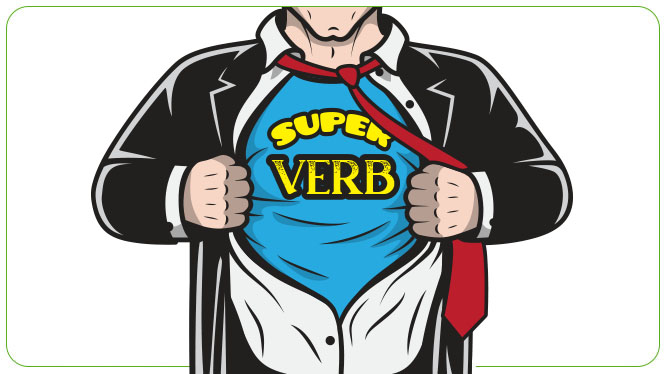What is a Verb?
Verbs take on the role of an action word in sentences. They are a major part of any language, next to nouns. They tell us what the subject (that is, a noun or pronoun) is doing. They are considered indispensable.
Verbs tell us what is happening. In English, even a sentence of two words must have a verb (for example: “John runs.”).
Some sentences can be created using only a single verb and nothing else, since the subject is implied (for example, “Eat!” “Go!” or “Drive!”)
Typically, we think of verbs as conveying action, that is, they are “doing” something in the sentence.
But this can be misleading. Some verbs are not easily recognized as actions. Consider for example the verbs am, feel, love, hope, think, or disagree. They may express thoughts, states of being, emotions, opinions, or senses.
As you will see in this section, there are many types of verbs!
How Can You Identify a Verb?
It’s easy to identify verbs. Just look for it’s place in the sentence in relation to the subject. As a general pattern, verbs usually come after a noun or pronoun. We refer to these as the subject. Consider the following examples:
Example
- Maria writes beautiful letters.
- They went to the supermarket after lunch.
- The giraffe ran across the savannah.
- The astronaut thought about her family every day.
English learners find it difficult to locate the verb in a sentence. The best way for this is to ask the right questions.
1st Question: Ask yourself “What is happening?”.
For example: is someone or something running, sitting, agreeing, voting, cooking, reading, jumping, thinking, and so on?
2nd Question: Ask this “Can I do ____?”
For example: can I run, sit, agree, vote, cook, read, jump, think, and so on?
If the answer is yes, then it’s safe to say that is a verbs.
Now that we know how to identify a verb, let’s discover about verb types.
Physical Verbs
A physical verb is one that directly describes an action. This includes not only movements of the body but also the use of tools. It even applies to instances where something is being done but is not very visible or “active” in the usual sense.
Consider the following examples of physical verbs:
- They ran to meet the ice cream truck down the street.
- Everyone I know voted in the last election.
- I sat in my favorite chair in front of the fireplace.
- Please call me sometime this weekend when you are free.
- Shall we cook some vegetables for dinner?
Mental Verbs
Verbs that are referred to as mental verbs are used to convey cognitive states, such as thinking, planning, understanding, or discovering.
Consider the following examples of mental verbs:
- I think I know who she is based on what you told me.
- Shanti always believes what people tell her, even when they are joking.
- Did he recognize you at the party last night?
- Angela discovered that the refrigerator was empty after the kids ate everything.
States of Being Verbs
State of being verbs are used to describe a situation or set of conditions and are inactive because they do not refer to a specific action being performed. They usually employ forms of “to be” (am, is, are) and are sometimes also called linking verbs.
Consider the following examples of state of being verbs:
- She is a professor of physics at the local university.
- They are world class athletes.
- This book is my favorite of all the ones in the library.
- Angela discovered that the refrigerator was empty after the kids ate everything.
Action Verbs
An action verb is used whenever you describe someone doing something, that is, to express an action. However, that action does not necessarily have to be something you can see or something that is physical.
Consider the following examples of action verbs:
- She reads better than her brother.
- My dog just thinks about food all day.
- Jeremy jumps higher than he did last year.
- The prime minister entertained foreign dignitaries.
Stative Verbs
Stative verbs describe states, including emotions, thoughts, measurements, or the senses. One way to remember this is that they do not describe an action, but rather a state that may even be a temporary one.
Consider the following examples of stative verbs:
- The teacher disagreed with Anna’s statement.
- ➡️ “Disagree” is a stative verb here, since it describes the teacher’s state of being, rather than an action.
- I believe in the power of positive thinking.
- Emily doubts that the package will arrive in time.
- Would you agree that this is the best television series of all time?
Irregular Verbs
Irregular verbs are verbs that take un unexpected spelling patterns in the past simple and past participle tense. Irregular verbs are actually fairly common in the English language, and you will encounter them frequently. We suggest taking some time to read through the list of irregular verbs.

